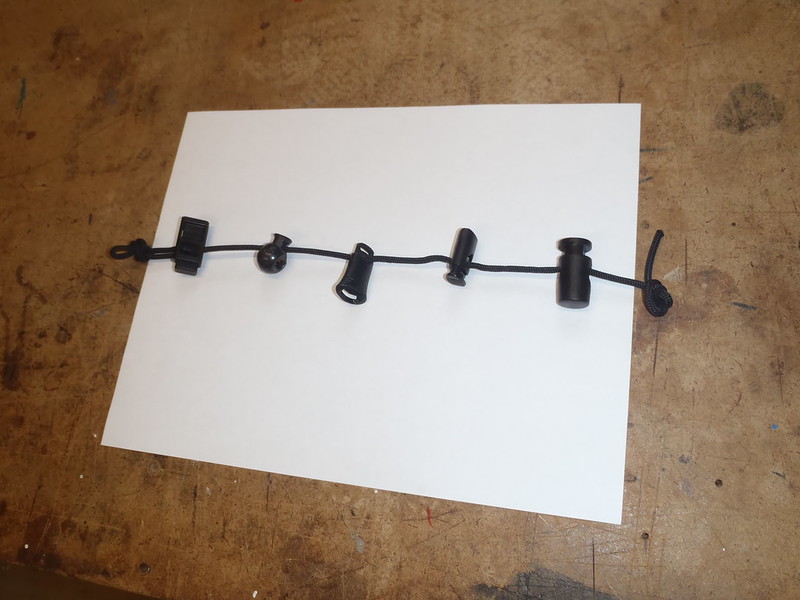G
Guest
Guest
A magnet has done well to pick out the occasional steel machine screw or nut from the stainless at the hardware store bins. When I get the cord locks with SS springs I’ll give it a try with the magnet and let you know
Got ‘em. ALSG and Conk got me wondering about cord locks; it doesn’t take much to get my experimental curiosity aroused. Down Conk, down boy, don’t get so excited.
I have a variety of cord locks, including the little round ball things that aren’t worth a fiddler’s dang, rectangular versions, ITW/Nexus “Award Winners”, Conk’s BigBoys and now, Sgt Knots “stainless steel” spring versions.
Some minor experiments were in order. First I tried picking up the various cord locks with a magnet. Actually, four different magnets, from weak little ½” circles to a seriously powerful 2 ¼” ceramic magnet.
To verify the validity of the magnet test I tried all of the magnets on various screws, nuts and washers in the stainless steel collection vs some comparable steel hardware. Most of the SS stuff was only weakly magnetic, except, unhappy discovery, the SS Nylocks.
That took a bit of diddling and repeat “testing”, waving the magnets over the cord locks to get them to at least wiggle if not levitate, and included the poor methodology caveat that the little round ball cord locks weigh next to nothing, while Conk’s BigBoy’s are, quote, “too heavy”. The Sgt Knots cord locks are kinda mid-sized, oval barrel 1 1/8” x 5/8”, with a 3/8” wide oval aperture. (OK, not “oval”, elliptical. dang grammarians)
Some of the cord locks were instantly attracted by any of the magnets, but Conk’s BigBoys and the Sgt Knots, despite having the largest metal springs, were only weakly attracted using the ceramic magnet, even given their larger size/weight.
The surprise was the discontinued ITW/Nexus cord lock, zero magnetic attraction even with the ceramic magnet, although that spring is completely hidden inside the slender “barrel”. Complete guess, but it could be that Conk’s BigBoys and the Sgt Knots cord locks have weakly magnetic stainless steel springs, and I’d bet the ITW/Nexus one does (did).
A purely observational test. The little round cord lock required almost no compression, and the spring on Sgt Knots cord lock was by far the most difficult to compress. Not unduly finger ouchie difficult, but it’s a helluva spring and oughta hold dang tight.
Actually the ITW/Nexus was the toughest, but that is an oddly different design; it doesn’t compress but instead pulls apart to reveal the opening, and requires both hands to do so. Not something you would want to adjust frequently, maybe why it is discontinued.
Another test. I strung five varieties of cord locks along a piece of paracord to see how difficult it was to slide them along the cord without removing the spring tension. That test was instantly revealing. From worst to best:
Little round-ball cord lock – all but useless, doesn’t hold worth a dang.
BigBoy cord lock – surprisingly the next easiest to slide uncompressed
Rectangular cord lock – hard to slide in one direction, easy in the other. It was some audible “toothy” rasp grip pulling to one side, which might not bode well for cord or bungee longevity.
Sgt Knots – hard to slide uncompressed in either direction
ITW/Nexus – Immovable. Impossible to slide even a little without (un)compressing.
Rather than ship them off to the seashore, where I can’t observe them and occasionally try to compress them, I want to hang them up outside the shop and induce artificial corrosion. I’m thinking dunk them in a glass of salty water once a week and see what happens over time.
But I’m amenable to other corrosion-inducing ideas, not sure my curiosity can wait for years.
Current take away without corrosion experiments – I need to pull out all of our stuff bags, tarp, tent, spray cover, chair bags, etc and replace some which I know have too-wimpy, don’t-hold-worth-a-dang cord locks. The OEM cord locks on some of our tents (looking at you MSR) are worthless.
Glad I ordered a fifty pack of those Sgt Knots cord locks, some for me, some for friends. And one for ALSG.
https://www.amazon.com/Crown-Spring-.../dp/B01N7ZDXSV













